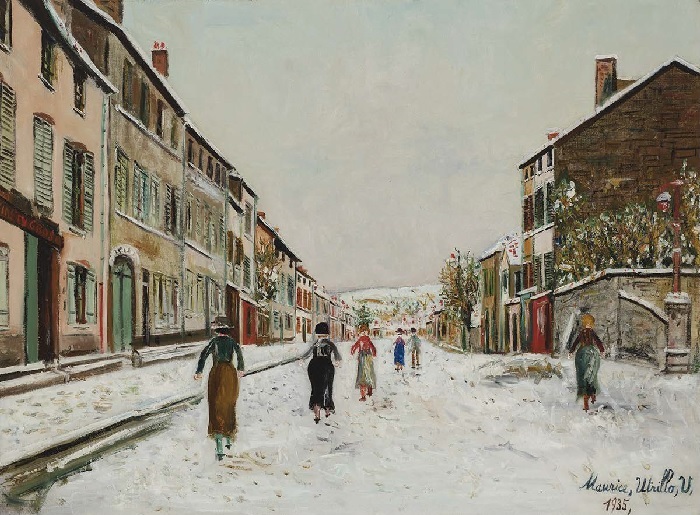
Maurice Utrillo
French, 1883-1955
Rue de Limoges, 1935
Oil on canvas
21 5/8 x 29 in.
SBMA, Gift of Adolf C. and Helen L. Pedotti, Trustees of the Pedotti Family Trust
1991.131.2
COMMENTS
French painter , son of Suzanne Valadon. He was entrusted to his grandmother while his mother posed as a model for such painters as Renoir and Puvis de Chavannes before discovering her own talent for drawing and painting. His father, the Spanish painter Miguel Utrillo (1862–1934), only admitted paternity eight years after Maurice’s birth. Maurice Utrillo had no predisposition for art, but when he was 19 his mother took medical advice and urged him to adopt drawing and painting as a distraction from his need for alcohol. In search of a suitable subject, he went to the countryside around Montmagny, a village to the north of Paris, where, between the autumn of 1903 and the winter of 1904, he completed almost 150 paintings, sombre, heavily impastoed landscapes, such as the "Roofs of Montmagny" (Paris, Pompidou). By 1906 the doctor felt that Utrillo could return to Montmartre. His pictures of the streets and suburbs were painted with a less heavy impasto and with lighter tones. He was attracted by ordinary houses, as in the "Rue du Mont-Cenis" and "Berlioz’s House" (both 1914; Paris, Mus. Orangerie), and suburban churches, for instance the "Church of Villiers-le-Bel" (1909; priv. col., see Pétridès, i, p. 129). These themes, associated with painters such as Daumier, Pissarro and Caillebotte, became Utrillo’s chief source of inspiration, but he soon turned to a more ambitious subject, cathedrals. He was concerned with the development of an ordered composition and a flattened treatment of space that suggested the artificial appearance of a theatre set, as in "Notre-Dame" (1909; Paris, Mus. Orangerie). Particularly during World War I he also found that such subjects allowed him to project strong emotions, as in "Rheims Cathedral in Flames" (1914; Basle, priv. col., see Pétridès, i, p. 67).
From 1909 until c. 1914 Utrillo mixed glue, plaster or cement with his paint to obtain the whites for which he became famous. His paintings of buildings show a striking contrast between the boldness of his colour and his painstaking draughtsmanship (traces of his having used a ruler and compass are often noticeable). Carried to their logical conclusion, these experiments led him to produce austere monochrome paintings in beige and grey.
His deteriorating health and social awkwardness led him gradually to withdraw from the streets of Montmartre into the relative safety of nursing homes. Here he developed the habit of painting from postcards (see Warnod, pp. 20, 26). His mother and stepfather, the painter André Utter (1886–1948), selected cards reproducing his favourite views of La Butte Montmartre. He worked from these either in their communal studio at 12 Rue Cortot, in the restaurant La Belle Gabrièle or in a bedroom above the Père Gay bistro. He exacted his revenge on the locals who had made his life difficult with their criticisms and jokes by depicting them in his paintings in rear view, as heavily outlined clumsy shapes and stereotyped silhouettes.
There is no hint in Utrillo’s work of the vicissitudes of his life: spells in homes; a move to the Château de Saint-Bernard in the Saône in 1923 with his mother and stepfather; his marriage to Lucie Pauwels (née Valore) in 1936 and consequent establishment in an orderly bourgeois existence at Vésinet; and various visits to the country. His late paintings, such as "Old House at Aubusson" (gouache on paper, 1935; Lausanne, Pal. Rumine) and "Village Street under Snow" (c. 1945; Albi, Mus. Toulouse-Lautrec), are characterized by rich colours and strong black contours and are almost entirely on landscape themes. From 1937 he was looked after by his friend and dealer Paul Pétridès at the request of his family. In spite of his wretched life he maintained a prolific output with a deep vein of poetic melancholy.
After his death his critical reputation declined, although he remained popular with collectors and the public.
- Colette Giraudon, Grove Art Online, 2003
